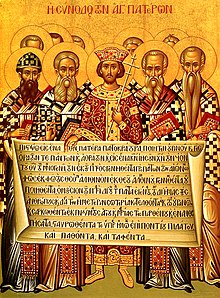Nicene Christianityincludes thoseChristian denominationsthat adhere to the teaching of theNicene Creed,[1]which was formulated[2]at theFirst Council of Nicaeain AD 325 and amended at theFirst Council of Constantinoplein AD 381.[3]

History
editAt the time of the First Council of Nicaea, the main rival of Nicene Christian doctrine was that ofArianism,which became eclipsed during the 7th century AD with the conversion of theGothic kingdomsto Nicene Christianity. The main points of dissent between the two centered onChristology,or the nature of Jesus' divinity. Nicene Christianity regards Jesus as divine and co-eternal with God the Father, while Arianism treats him as the first among created beings and inferior to God the Father. Various other non-Nicene doctrines and beliefs have existed since theearly medieval period,all of which have been consideredheresies.[2]
Religious historians and scholars often define Nicene Christianity as being the first incarnation of thestate church of the Roman Empirethat was officially endorsed by the Roman Emperors from 381. According to this definition, the Nicene Church ceased to exist following theCouncil of Chalcedonin 451, which was convened to address Christological disagreements on the human and divine natures of Christ, concluding that Christ had two separate natures. Following the council, the Roman Empire establishedChalcedonian Christianityas its official state religion; those churches which held that Christ was of a single nature wereexcommunicatedby the Empire and became theOriental Orthodox Churches.
- (Not shown areante-Nicene,nontrinitarian,andrestorationistdenominations.)
Today, examples of non-Nicene Christian denominations encompass both Protestant and non-Protestantnon-trinitariangroups. Examples of these groups include the majority of theLatter Day Saint movement(with the exception of the Nicene Mormon group known as theCommunity of Christ[formerly known as the Reorganized Church of Jesus Christ of Latter Day Saints]), theUnitarian Church of Transylvania,Oneness Pentecostals,and others.[citation needed]
See also
editReferences
editCitations
edit- ^World Encyclopaedia of Interfaith Studies: World religions.Jnanada Prakashan. 2009.ISBN978-81-7139-280-3.
In the most common sense, "mainstream" refers to Nicene Christianity, or rather the traditions which continue to claim adherence to the Nicene Creed.
- ^ab"Nicene Creed".Encyclopedia Britannica.3 January 2020.Retrieved28 February2020.
- ^Siddhartha 2009,p. 733.
Sources
edit- Siddhartha, Anand (2009).World Encyclopaedia of Interfaith Studies: World religions.Vol. 3. New Delhi: Jnanada Prakashan.ISBN978-81-7139-280-3.
- Spinks, Bryan D. (2013).Do this in Remembrance of Me: The Eucharist from the Early Church to the Present Day.SCM Press.ISBN978-0-334-04376-8.